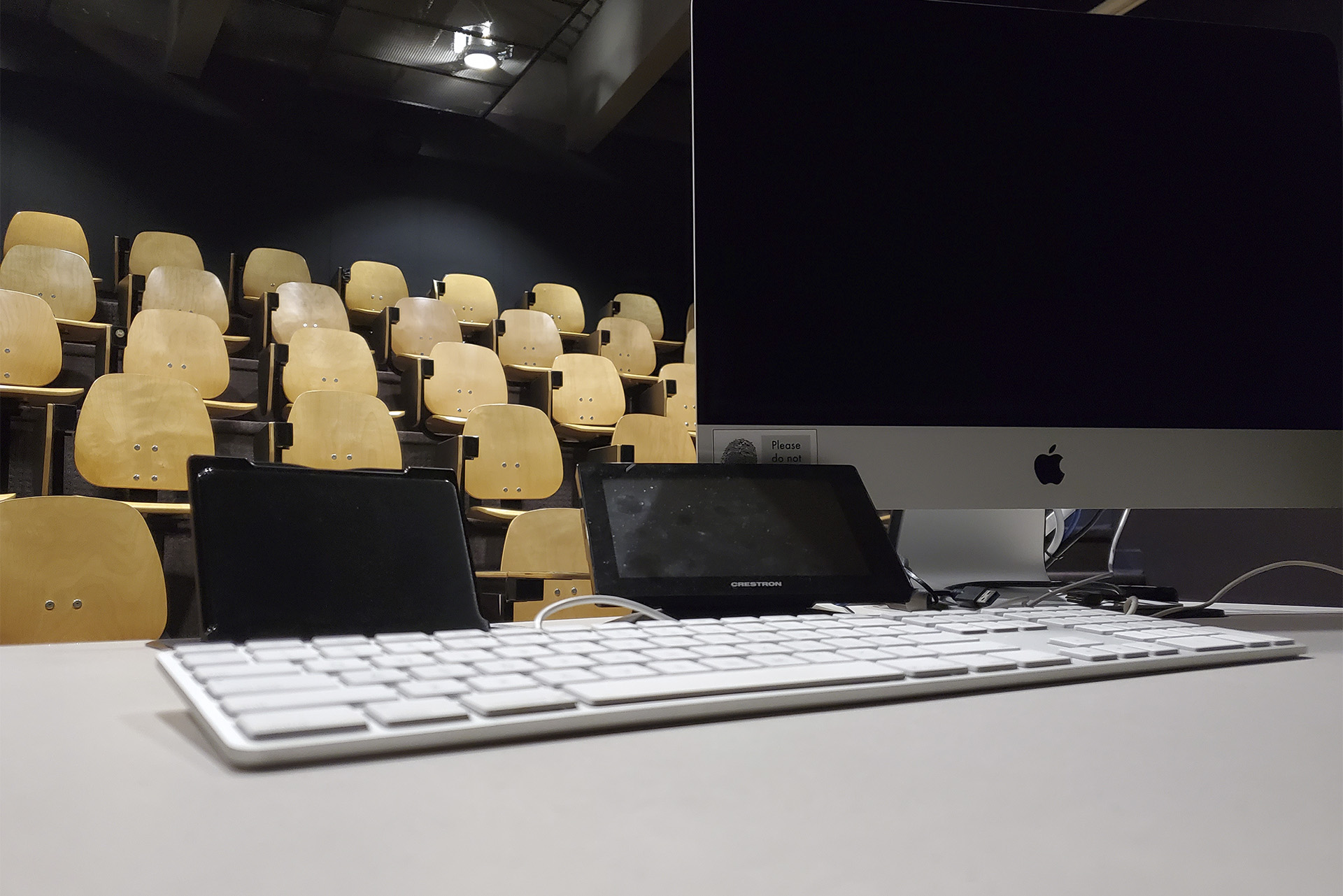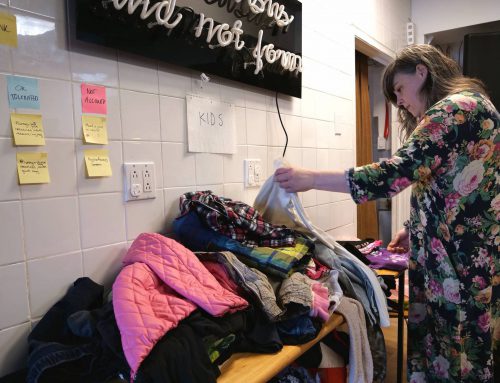BY Sacha Obas & Alexis Deleon-Giron
“I don’t know what it was, but I could just smell something was just about to happen,” says Saul Carliner, a director of the educational technology program at Concordia University.
It was March 11, 2020. Quebec had only seven reported cases of the flu-like illness. Air Canada had canceled flights to Italy, but most other travel went on as normal. Still, Carliner sensed a lockdown was coming.
On that day, he sent an email to two other senior members of the Education department saying he felt the university would soon need to transfer all its courses online and he was ready to help.
“But they told me they didn’t need my help,” Carliner says. “They were prepared.”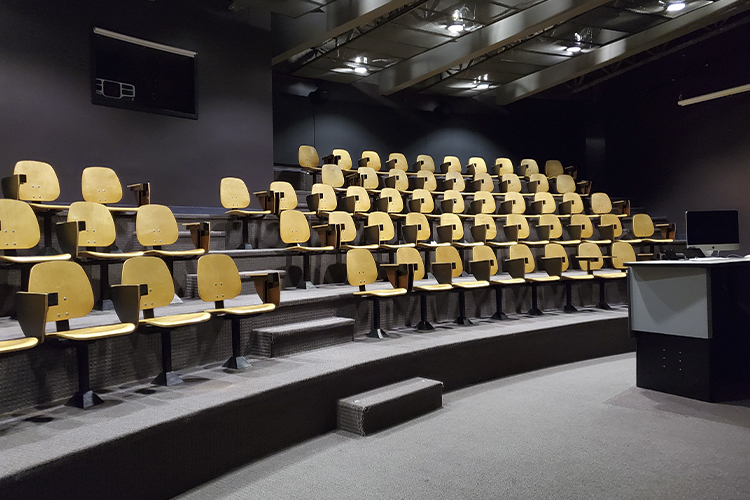
Empty Communications Studies auditorium inside Concordia University’s CJ building on its Loyola Campus in Notre-Dame-De-Grâce, Montreal. Photo by Alexis Deleon-Giron.
On March 12, the government announced that universities across Quebec would be closing for two weeks. By 8:15 p.m., Concordia announced it would attempt to have most classes transferred online by March 23.
Between those two announcements, Carliner received a second response from the Education department. This time they accepted his offer to help.
He says that although every online tool currently being used by faculty to teach was accessible before the pandemic, most had never used them, and those who had were only using one or two of its functions.
“My job was basically just being a volunteer supervisor,” says Carliner.
Along with a colleague, he was tasked with selecting and managing a group of 40 post-graduate education students who would assist faculty transition to teaching online.
Over the summer, the Centre for Teaching and Learning lead 91 workshops with 2,500 participants for the online transition and currently still provide one-on-one support through video calls and emails, departmental meetings, town halls and drop-in Q&A sessions.
“Most of my colleagues never would have wanted to have to teach like this,” Carliner says. “Nature had a gun to their heads, but so far they are loving it.”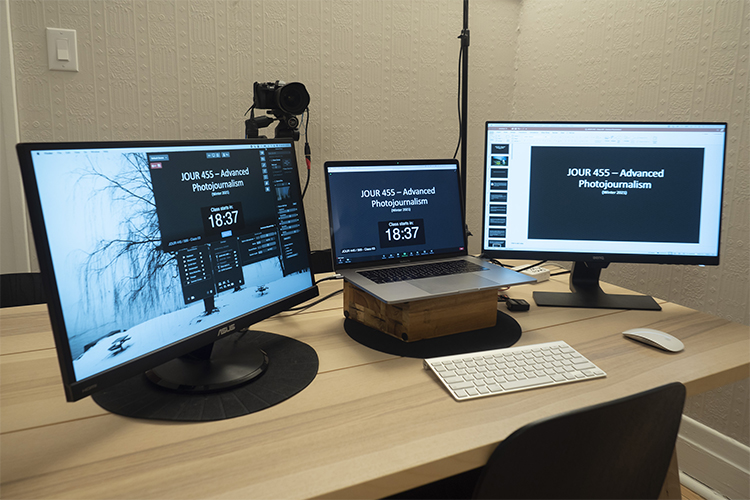
Visual Journalism Professor Dario Ayala’s at-home setup for his taught courses at Concordia University, such as his Advanced Photojournalism winter 2021 course. Photo courtesy of Dario Ayala.
According to a recent survey conducted by the Concordia University Faculty Association, most of its members are not loving the experience.
Professors reported a “significant extra work overload” and many of them “worry their research is suffering from this situation as more time is dedicated to teaching and Zoom meetings, leaving little time for research.”
The survey also showed that most professors miss having direct contact with students, feeling that Zoom sessions can’t efficiently replace classroom interactions.
Luis Ochoa, a lecturer for the Spanish language program at Concordia, had no issues learning the software. The professor says he’s been using Moodle since it’s been adopted by university and has always loved it, but admits that he doesn’t love all the extra time it is taking him to prepare the online material for his classes.
“But if you want to create interesting activities and really want the students to learn, that’s what it takes,” he says.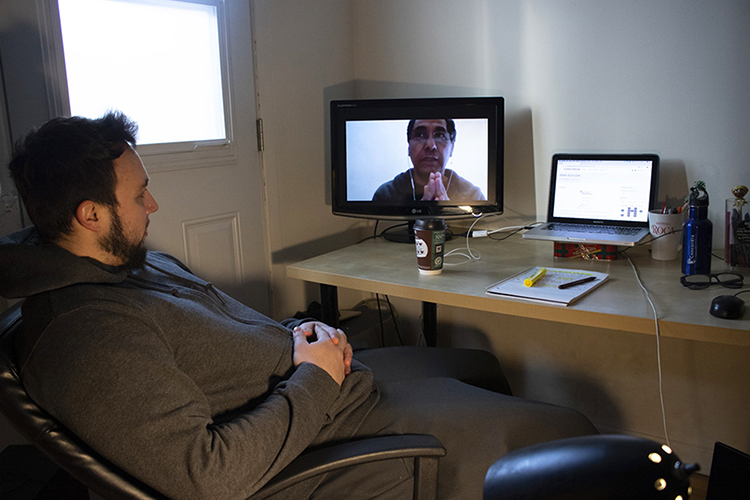
A student watches Spanish language professor Luis Ochoa’s online lecture. Photo by Sacha Obas.
Not only does Ochoa deliver synchronous lectures for every one of his courses where he has his students do activities and practice speaking in breakout rooms. He also delivers, on average, one hour of additional asynchronous lectures per week, which each contain several interactive activities, in addition to the regular exercises he has to prepare and correct.
Online teaching inside McGill University’s education department in Ville Marie, Montreal. Video by Alexis Deleon-Giron.
Psychology student Mariah Fridman, who was diagnosed with ADHD as a child, says having lectures recorded and accessible to students at all times has been very helpful, particularly since students with disabilities haven’t had access to notetakers since the pandemic started. Despite these benefits, the student says her experience with online courses hasn’t been pleasant.
“I just had moments where I felt that this is just more difficult than this needs to be,” she says.
According to Fridman, when courses first went online she felt some professors provided too many asynchronous courses. She feels it created too great a distance between teachers and students.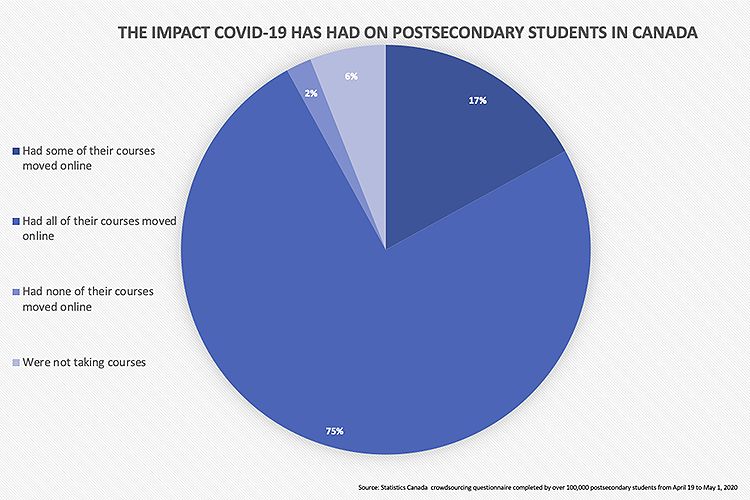
Classes have moved entirely online for many departments during the pandemic. Media by Sacha Obas.
Carliner equates the experience of transitioning to online teaching, to that of an actor who transitions from the stage to live television.
“You’re not going as big, or as loud, but you are still acting for an audience,” he says. “Some class time has to be dedicated to genuinely showing your students that you are interested in their lives and in their success.”
“I’m lucky because I’m teaching the text courses,” says Wayne Larsen, a professor in Concordia’s journalism department. “You send me a word document in an email, and I send it back with comments on it. You can’t get any more basic than that.”
Larsen had planned to retire at the end of last year’s winter semester but was asked to stay another year once the pandemic hit. He attended a few of Concordia’s faculty online teaching development workshops held over last summer but says he tries to keep his courses as low-tech as possible “to keep the feel of the classroom.”
“In September it was crazy,” Larsen says. “It was me and a bunch of rectangles with people’s names. I would sometimes call somebody’s name and I would hear crickets—the person wasn’t there.”
Larsen says things got a lot better in the second semester under lockdown. Faces started outnumbering the black rectangles on his computer screen. And although conversations did not get as natural as he would like due to students having to turn on and off their microphones every time they wanted to speak, he says they participated a lot more.
“It’s just that there’s an adjustment period for both professors and students that we have to expect,” says Carliner.
According to him, most of the studies comparing online to classroom courses have shown that they are equally as effective, but he says what needs to be studied now is what it means to put an entire program online.
“No one wants to talk about it, but even going to parties and grabbing a beer, which I don’t think the university should be promoting, are all part of the undergraduate experience,” he says. “And that’s something we have to acknowledge that people are missing out on.”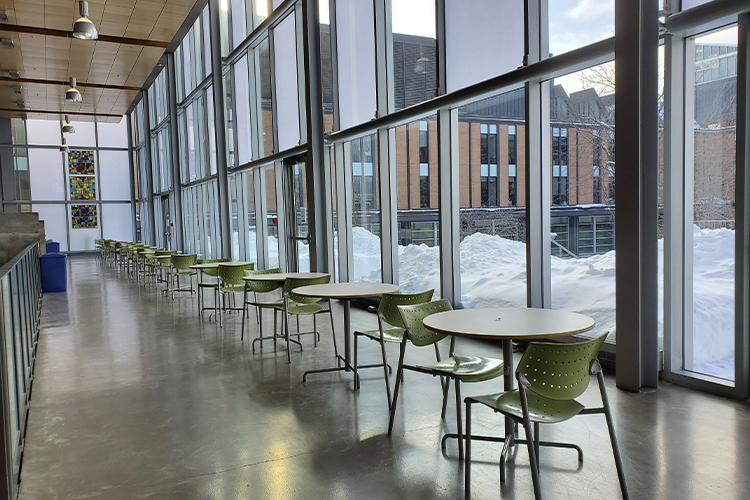
Empty cafeteria inside Concordia University’s CJ building on its Loyola campus in Notre-Dame-De-Grâce, Montreal. Photo by Alexis Deleon-Giron.
Carliner says adjusting to online courses is the easy part. The challenge for universities has been to create a complete university experience online.
“In an era of online learning, why would people pay $60,000 to get into one of these highly ranked MBA programs for an education you can probably get online for a lot less?” asks Carlier. “We are not going to have a complete answer to that anytime soon. But one of the things that’s apparent is that you are paying for the connections.”
In the Fall, Concordia launched “Homeroom,” a year-long virtual program held weekly with students in groups of fifteen to twenty. Led by upper-year student facilitators, the program was designed to increase new student connection to peers and the institution while breaking isolation. It also created a weekly live Q&A it calls the “Student Service Station,” where students can drop to a Zoom session and ask questions to staff members from diverse Concordia units.
